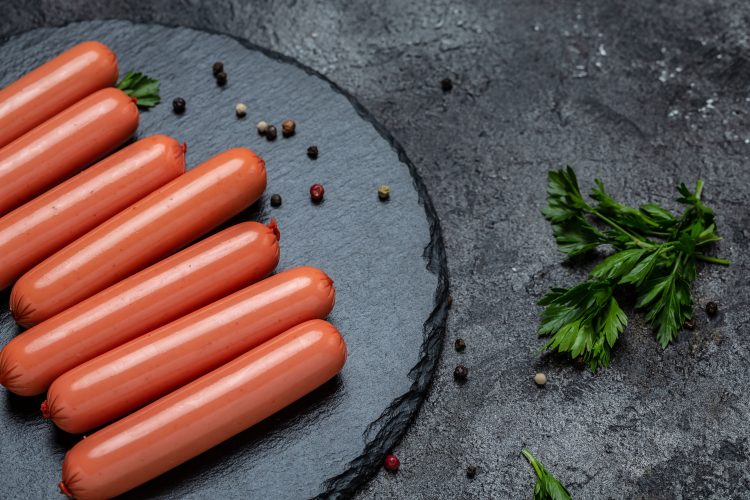Will plant-based meat alternatives ever be as popular as meat?
- Like
- Digg
- Del
- Tumblr
- VKontakte
- Buffer
- Love This
- Odnoklassniki
- Meneame
- Blogger
- Amazon
- Yahoo Mail
- Gmail
- AOL
- Newsvine
- HackerNews
- Evernote
- MySpace
- Mail.ru
- Viadeo
- Line
- Comments
- Yummly
- SMS
- Viber
- Telegram
- Subscribe
- Skype
- Facebook Messenger
- Kakao
- LiveJournal
- Yammer
- Edgar
- Fintel
- Mix
- Instapaper
- Copy Link
Posted: 14 July 2021 | Grace Mongey, Ronan Gormley | No comments yet
Grace Mongey and Ronan Gormley report on developments in plant-based meat alternatives, including the drivers, protein sources, ingredients and more…


The European plant-based market is expected to grow to €18.3 billon by 20231, representing an exciting opportunity for SMEs and large companies alike to engage in plant-based ‘meats’.
Drivers of plant-based meat product development
Today’s consumers are concerned with global warming, animal welfare and healthy eating. Meat production is a major contributor to greenhouse gases but producing an equivalent amount of isolated soy protein has a much lower carbon footprint and so it has proven as a popular protein source in alternative products.2 However, increasing household income and urbanisation has caused the demand for meat and meat products to continue to grow.3
Yet, there are a number of drivers which are leading to a more flexitarian/vegetarian/vegan way of life.
Animal welfare issues such as housing in close proximity to each other, alterations (eg, tail docking and beak-trimming), and the slaughtering of young animals to ensure flavour and tenderness are all drivers for a change in diet. Health is also an incentive; while meat is a good source of key nutrients, it holds negative health connotations in consumers’ minds around saturated fat and cholesterol content, as well as a link to inflammatory diseases.
Heterocyclic amines (HCAs) produced during cooking meat at high temperatures for long periods are also a driver as it can induce tumour development in animal models,4 along with the potential for reactive oxygen species that may be formed during processing/cooking.
Protein sources/ingredients/formulation
A major challenge in developing plant-based meat products is achieving a protein quality equivalent to meat. Soy is considered a complete protein and textured soy protein. An extruded product like soy is a popular alternative in plant-based ‘meats’ due to its nutritive value, functional properties and versatility.
However, soya is also one of the major food allergens and must be declared if included in the ingredients. Pea protein isolates do not fall within the allergen list and so offer an interesting alternative. Pea protein has adequate functional properties and its oil holding capacity can improve flavour retention and product mouthfeel.
Gluten is also used to make seitan, which has a meat-like texture without the meat taste. Boiling the gluten mass in a savoury solution imparts flavour resulting in a textured shredded meat-like material.5
Rice protein isolate is hypoallergenic and is used in plant-based meats either on its own or in combination with other plant-based proteins. Other protein sources with potential for inclusion in plant-based meats include algae (eg, Spirulina platensis6), peanut protein concentrate, rapeseed meal, quinoa and protein from surplus potatoes.7
Table 1: Protein and fat sources in six brands of plant-based meat products. From ingredients list on pack
|
Product |
Protein source |
Fat source |
|
Meat-free sausages |
Soy protein and wheat gluten |
Sunflower/soy/rapeseed oils |
|
Vegetarian sausages |
Textured soy protein |
Rapeseed oil |
|
Vegan bacon |
Vital wheat gluten |
Sunflower oil |
|
Chicken free goujons |
Pea and wheat protein |
Rapeseed oil |
|
Meat-free burger |
Soy and wheat protein |
Coconut oil |
|
Plant-based steak |
Seitan (wheat protein) |
Coconut fat |
Spirulina platensis is one of the most commonly used algae in the food industry due to its potent antioxidant ability and high essential amino acid, protein, vitamin and mineral content.7 Protein and fat sources in six brands of plant-based meat products are provided in Table 1.
In Ireland, where we (the authors) reside, it is estimated that 4.3 percent of the population are vegetarian and 4.1 percent are vegan,8 encouraging meat companies to produce plant-based alternatives to the offering.
If we take a brand of pork sausages and their plant-based counterparts (produced by the same company) as an example, there will be a distinct difference in ingredients but with the latter comprising a more natural list. Examples for pork vs. plant-based sausages include:
- Sodium triphosphate (stabiliser and promotes juiciness) vs. methylcellulose (plant derived)
- Sodium metabisulphite (preservative) vs. spices
- Carmine (colourant from insects) vs. safflower and beetroot juice (plant-based)
In the example we looked at, the plant-based sausages containing inulin (a dietary fibre from chicory roots) – which positively effects blood insulin levels – has a bland flavour, a fat-like mouth feel/texture, and improves emulsion stability.9 The protein sources in these plant-based sausages are rehydrated textured soy protein and wheat protein.
Generating flavour and texture in plant-based meats
Sensory acceptance of plant-based meat products is key. Hydrolysed vegetable proteins (HVPs) from soy, corn or wheat are the primary forms of protein present in plant-based meats. HVP is high in free amino acids and peptides which enhance flavour, thus improving the perceived taste of the product.10 Yeast extracts are also used as they have sulphur-containing volatiles which impart a meaty aroma following thermal treatment.11
Spices such as red, white and black pepper, mustard, garlic, allspice and cinnamon are used extensively in plant-based meat products to impart/enhance or mask flavours and also because of their nutritional, antioxidant, anti-inflammatory and antimicrobial properties.


Whole muscle meat alternatives are produced using high moisture or wet extrusion, resulting in a fibrous chunk of plant protein (usually soya), similar to that of real meat.13 Soya is often supplemented with other ingredients, such as pea protein or gluten, to add additional nutritional and physical properties, for example gluten on heating coagulates to form a moist, resilient gel which makes it an ideal partner ingredient in the production of plant-based chicken and meat.14
Extrusion enhances juiciness, tenderness, colour (via Maillard reaction and caramelisation), protein availability and protein digestibility of the extrudate. Hydrocolloids such as carrageenan from red algae improve firmness and the development of fibres. Other thickening agents may be used, such as tomato pomace as it contains high levels of pectin and improves hardness/cohesiveness and moisture retention in meat-free sausages.15
Consumer acceptance
Appearance, flavour and texture attributes of plant-based meats are key to acceptance. Consumers have concerns over a range of ingredients/additives which can be found in plant-based meats, but it’s worth noting that traditional meat products also include a range ingredients and additives.
Campaigns to promote plant-based diets include ‘Veganuary’ (vegan diet for January), and ‘Meatless Monday’ (no animal meat to be consumed on Mondays). A recent study on consumer acceptance of plant-based meat products based on information on the packaging showed that including two environmentally informative messages on the front of the package enhanced product image/acceptability.16
Currently, plant-based meat products are usually more expensive than their meat counterparts which stifles uptake, however, rising costs of real meats may offset the differential.
Research on the safety of plant-based meat products is limited as it is a new area, but the ingredients/additives used are ‘Generally Recognised as Safe’ (GRAS status). Moreover, shelf life of plant-based meats is generally longer than meat products as ingredients tend to be less microbiologically sensitive.
While plant-based meats will command an increasing market share (at least in the medium term), beef, pork, lamb and chicken will continue to hold centre stage for flavour, texture and perceived naturalness.
References
- Kerry. 2020. Introducing plant-based food innovation. RADICLETM by Kerry, 24 pages
- DuPont, 2018. DupontTM Danisco® ISP has the smallest carbon footprint. Innovations in Food Technology, August, page 19
- Thornton, P.K. 2010. Livestock production: Recent trends, future prospects. Philosophical Transactions B, 265 (1554), 2853-2867
- Zheng, W. & Lee, S.-A. 2009. Well-done meat intake: heterocyclic amine exposure & cancer risk. Nutrition & Cancer, 61(4), 437-446
- Anwar, D. & El-Chaghaby, G. 2019. Nutritional quality, amino acid profiles, protein digestibility, corrected amino acid scores & antioxidant properties of fried tofu & seitan. Journal of Faculty of Food Engineering, Stefan cel Mare University of Suceava, Romania, 18(3), 176-190
- Kouser Ali, S. & Saleh, A. M. 2012. Spirulina – An overview. International Journal of Pharmacy & Pharmaceutical Sciences, 4(3), 9-15
- Jiménez Munoz, L.M., Tavares, G.M. & Corredig, M. 2021. Design future foods using plant protein blends for best nutritional and technological functionality. Trends in Food Science & Technology, 113, 139-150
- Bord Bia. 2018. Dietary Lifestyles Report
- Choi, H.-S. & 6 co-authors. 2016. Effect of chicory fiber & smoking on quality characteristics of restructured sausages. Korean Journal for Food Science of Animal Resources, 36(1), 131-136
- Jeon, S.-Y., Lee, Y.-M., Kim, S.S. & Kim, K.-O. 2020. Effect of hydrolysed vegetable proteins on consumers’ response for Doenjang (Korean traditional fermented soybean paste) soup. Food Science & Biotechnology, 29(1), 45-53
- Lin, M. & 5 co-authors. 2013. Aroma-active components of yeast extract pastes with a basic & characteristic meaty flavour. Journal of the Science of Food & Agriculture, 94(5), 882-889
- Dekkers, B.L., Boom, R.M. & van der Goot, A.J. 2018. Structuring processes for meat analogues. Trends in Food Science & Technology, 81, 25-36
- de Angelis, D. & 7 co-authors. 2020. Physicochemical & sensorial evaluation of meat analogues produced from dry-fractionated pea & oat proteins. Foods, DOI: 10.3390/foods9121754
- Asgar, M.A. & 4 co-authors. 2010. Nonmeat protein alternatives as meat extenders & meat – analogues. Comprehensive Reviews in Food Science & Food Safety, 9(5), 513-529
- Savadkoohi, S., Hoogenkamp, H., Shamsi, K. & Farahnaky, A. 2014. Colour, sensory & textural attributes of beef frankfurter, beef ham & meat-free sausage containing tomato pomace. Meat Science, 97(4), 410-418
- Martin, C., Lange, C. & Marette, S. 2021. Importance of additional information, as a complement to information coming from packaging, to promote meat substitutes: A case study on a sausage based on vegetable proteins. Food Quality & Preference. www.sciencedirect.com/science/article/pii/S095032932030327X?via%3Dihub
About the authors




Grace Mongey is fourth year food science student in the School of Agriculture and Food Science in University College Dublin. The data presented here are part outcomes from her fourth year food science project which was conducted in the period September 2020 to March 2021 inclusive.
Related topics
Ingredients, Plant based, Product Development, Sustainability
Related organisations
School of Agriculture and Food Science, University College Dublin









